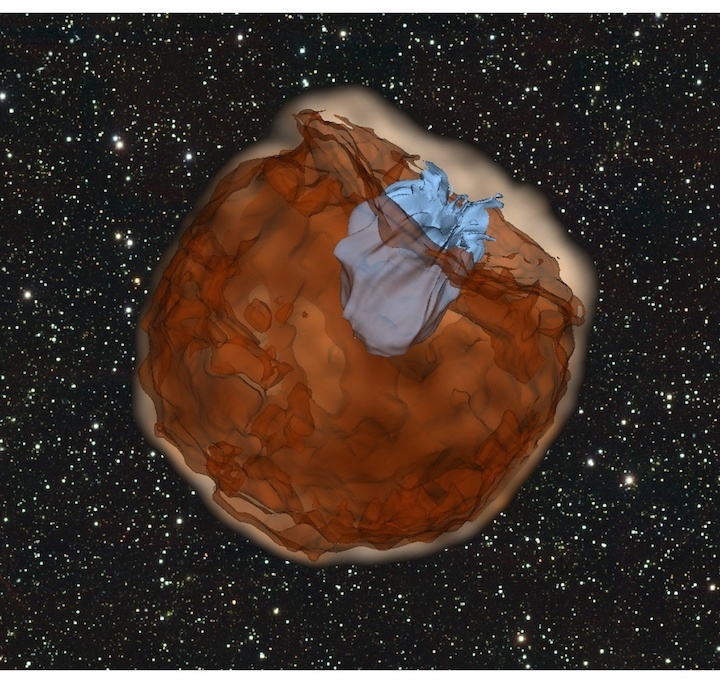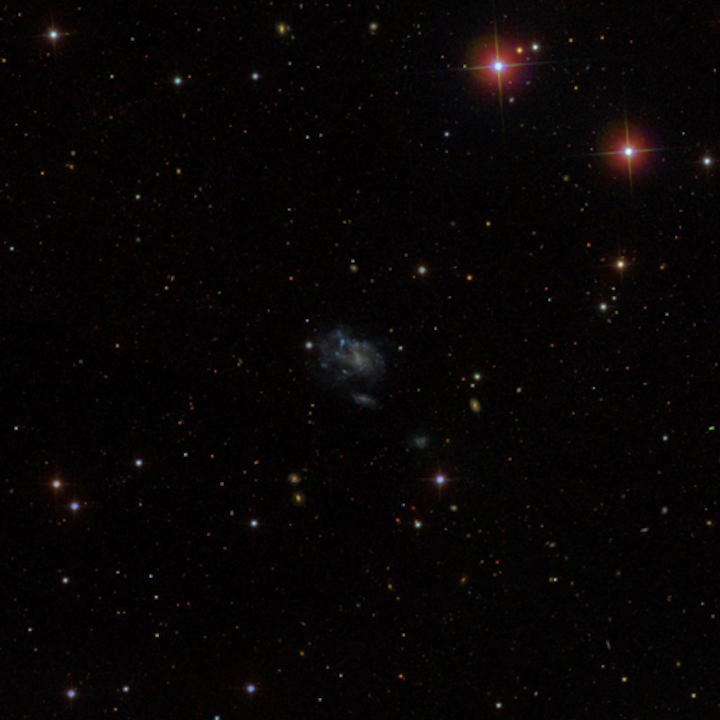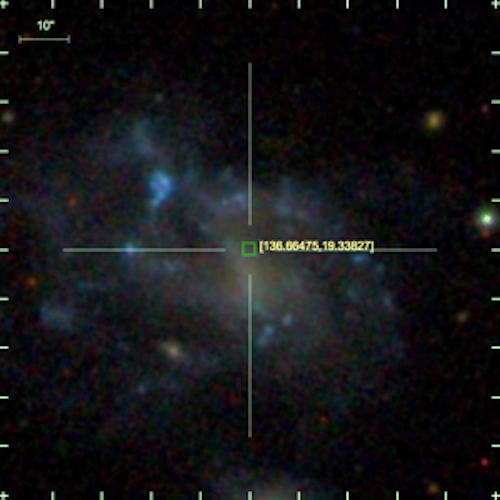In a galaxy far away, an old star exploded and became a supernova. About 170 million years later on Feb. 4, 2018, the light emanating from the explosion was received by an arsenal of high-powered telescopes.
NASA’s Kepler space telescope detected the unfurling light of SN 2018oh, as it has been labeled. The first ground-based facility to identify the signal was with the All-Sky Automated Survey for Supernova and soon observatories around the globe were monitoring the supernova as part of a unique scientific experiment designed to help solve the mystery of how stars explode.
NASA retired the Kepler space telescope on October 30, following the exhaustion of fuel supplies after nine and a half years of ground-breaking operations. But from December to May, while there was still fuel left, the Kepler team oriented the spacecraft toward two distinct patches of sky that were simultaneously observable from Earth by ground-based observatories. The telescopes were able to view both patches of sky teeming with galaxies. Each of these thousands of galaxies has billions of stars.
While the telescopes watched, a few of those stars ended their long lives in dramatic explosions. With its unique capabilities, Kepler observed the minute changes in brightness of these explosions from their very beginnings while the ground-based telescopes tracked changes in color and the atomic composition of these dying stars.
With the combined data from these telescopes, astronomers achieved what they had hoped for — an unprecedented observation of the onset of a supernova. Three research papers by 130 scientists attempt to explain the unusual data revealed in the details of SN 2018oh, which was caught in the spiral galaxy UGC 4780 in the Cancer constellation. One of the papers has been accepted for publication in The Astrophysical Journal Letters, while the other two have been accepted to The Astrophysical Journal.
A hot, bright burn
SN 2018oh is an example of a Type Ia supernova — the kind that astronomers use to track the expansion of the universe and probe the nature of the invisible “dark energy” that glues together the cosmos.
A typical Type Ia supernova brightens over the course of three weeks before gradually fading away. But Kepler observed this particular supernova brightening rapidly a few days after the initial explosion — about three times faster than a typical supernova at this time period — before reaching peak brightness. Meanwhile, color details obtained by the Dark Energy Camera at Cerro Tololo Inter-American Observatory in Chile, and the Panoramic Survey Telescope and Rapid Response System at Haleakala Observatory in Hawaii, showed this supernova gleaming blue during this period of intensity, an indication of high temperatures.
For nearly a decade, scientists have been in search of a signal of a supernova similar to this one. Because Kepler was already staring at this patch of sky before the supernova went off, it was able to detect its early signals and measure it continuously for weeks.
The scenarios giving rise to Type Ia supernovae have been long-debated. So far, most evidence points to the merging of two white dwarfs, the compact corpses of stars, as the source of these explosions. Yet theoretical models have held out the possibility of an alternative scenario, in which a single degenerate white dwarf siphons off so much material from its companion star that it can no longer sustain its own weight and blows up.
Some of the scientists examining SN 2018oh’s peculiar data believe it is a compelling example of this alternative scenario. They explain that the shock wave from the exploding white dwarf ran into the companion star, creating an extremely hot and bright gaseous material that accounts for the added brightness and heat observed.
Another group of scientists favor a different mechanism to explain the excess flux of light and temperature. Type Ia supernovae produce radioactive nickel during the explosion. The radioactive decay of this heavy metal produces much of the light we see from Type Ia supernovae. If a large amount of nickel was located in the outer layers of the exploding material it would produce the observed early bump in the light.
Refining the models
If the single degenerate white dwarf theory holds true for SN 2018oh, the next step is to figure out the frequency of this kind of Type Ia supernova. If, however, the theory of nickel in the outer layers prevails, we will glean details about the inner workings of supernova explosions. Either way, understanding the details of Type Ia supernovae are important for refining the models used in cosmology to estimate the expansion rate of the universe.
The team of astronomers detected more than 40 supernova candidates during this experiment with Kepler, including several others that are also proving scientifically interesting. Though Kepler’s fuel has run out and cannot be replaced, the data it has collected on supernovae, exoplanets and other astronomical phenomena will be studied for many years to come.
The authors of these papers include scientists from dozens of institutions, including members of the Kepler team. Additional observatories providing valuable data to support the experiment include Las Cumbres Observatory, a global network of robotic telescopes based in Goleta, California; Tsinghua-NAOC and Lijiang Telescopes in China; Konkoly Observatory in Hungary; Lick Observatory on Mount Hamilton in California; Las Campanas Observatory in Chile, and others.
NASA's Ames Research Center in California’s Silicon Valley manages the Kepler and K2 missions for NASA’s Science Mission Directorate. NASA's Jet Propulsion Laboratory in Pasadena, California, managed Kepler mission development. Ball Aerospace & Technologies Corporation operates the flight system with support from the Laboratory for Atmospheric and Space Physics at the University of Colorado in Boulder.
The above animation shows the scenario leading to a particular kind of Type Ia supernova in which a single white dwarf siphons off so much material from its companion star that it can no longer sustain its own weight and blows up. It is one theory explaining the data from SN 2018oh. Image Credit: NASA/JPL-Caltech
LCO and NASA’s Kepler work together to determine origins of supernova
Astronomers at Las Cumbres Observatory (LCO) are part of an international team of scientists who used NASA’s Kepler satellite to catch a rare glimpse of a Type Ia supernova minutes after explosion. The supernova, named SN 2018oh, was brighter than expected over the first few days. The increased brightness is an indication that it slammed into a nearby companion star. This adds to the growing body of evidence that some, but not all, of these thermonuclear supernovae have a large companion star that triggers the explosion.
Las Cumbres Observatory (LCO), based in Goleta, California, is a global network of 21 robotic telescopes that obtained some of the best data characterizing the supernova in support of the NASA mission. Wenxiong Li, the lead author of one of three papers published today on the finding, was based at LCO when much of the research was underway. Five other LCO astronomers, who are affiliated with the University of California Santa Barbara (UCSB), also contributed to two of the papers.
Understanding the origins of Type Ia supernovae is critical because they are used as standard candles to map out distances in cosmology. They were used to discover Dark Energy, the mysterious force causing the universe to accelerate in its expansion. Astronomers have long known that a supernova is the explosion of a dense white dwarf star (A white dwarf has the mass of the sun, but only the radius of the Earth; one teaspoon of a white dwarf would weigh roughly 23000 pounds) What triggers the explosion is less well understood. One theory holds that the explosions are the merger of two white dwarf stars. Another is that the second star is not a white dwarf at all, but a normal-sized or even giant star that loses only some of its matter to the white dwarf to initiate the explosion. In this theory, the explosion then smashes into the surviving second star, causing the supernova to be exceedingly bright in its early hours.
Testing the theory was deemed so important to NASA that some of the last few months of the life of the Kepler satellite were dedicated to looking for this phenomenon. Kepler’s ability to take data over large regions of the sky every few minutes was unique and it allowed scientists to observe this type of supernova at the earliest moments in the explosion — the earliest ever seen.
When the Kepler satellite observed a supernova, it needed support from other instruments. Because the satellite measures just the brightness of light and only sees in black and white, astronomers also used ground-based telescopes to watch the explosion in color and to obtain spectroscopy to reveal its chemical signatures. Regular ground-based telescopes do not have the massive field of view of Kepler and are restricted by the rotation of the Earth — observations are limited to local nighttime. Las Cumbres Observatory, with its network of telescopes all over the Earth, always has telescopes ready in the dark. The LCO network, like Kepler, can stare at the same spot for 24 hours and more.
“Kepler and Las Cumbres Observatory’s capabilities are so complementary, I’ve been dreaming about using them together to address the origins of Type Ia supernovae for years. It is amazing to see it finally happen.” said Andy Howell, who is head of the supernova group at LCO, a member of the faculty at UCSB, and a coauthor on two of the papers.
The Kepler satellite normally points backwards in its orbit, away from Earth. NASA decided that this was necessary both to shield the satellite’s optics from debris and to avoid the glare of Earth overwhelming the sensitive detectors. Targets seen in this direction from Kepler are not visible from the ground-based telescopes for very long. With Kepler nearing the end of its life, NASA decided to take the risk of pointing the telescope forward in its orbit. This allowed LCO to simultaneously take data while Kepler was observing the supernova.
Howell added, “It really speaks to their spirit of discovery at NASA that they took a risk in the name of science with Kepler. It paid off!”
This is not the first time that distortions in the early light of thermonuclear supernovae have been seen. Similar effects were observed in supernovae in 2012, 2014, and 2017. Las Cumbres Observatory was the only facility to have played a role in all of these studies [see the story here]. The interpretation of the results has not always been straightforward. The event in 2012 had sparse data. The one in 2014 was a very unusual supernova. The one from 2017 failed to match other theoretical predictions associated with a supernova having a large companion star. Even the new supernova is not without controversy — some scientists on the large international team think other explanations can account for the strange early behavior of the supernova.
“This was so exciting because it was a rare case that as observers we got to go look for something that had been predicted from computer simulations,” said Curtis McCully who is a scientist at LCO and a coauthor on two of the papers.
Further observations of SN 2018oh and other supernovae like it may settle the controversy over its strange behavior in the early days just after its explosion. While NASA’s Kepler is out of gas, Las Cumbres Observatory is just getting started.
McCully added, “With new technology like the LCO network of robotic telescopes and Kepler spacecraft, we have moved out of the era of still photographs to motion pictures of the universe: it’s such an exciting time to be in astronomy as we search for what really goes bump in the night.”

Simulation of a supernova explosion (brown) hitting a companion star. This causes some of the supernova ejecta to glow blue, and creates a hole in the ejecta. The result is a bump in brightness of the supernova soon after explosion. Credit: Dan Kasen (Berkely/LBNL)
Quelle: Las Cumbres Observatory



